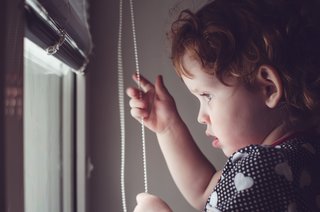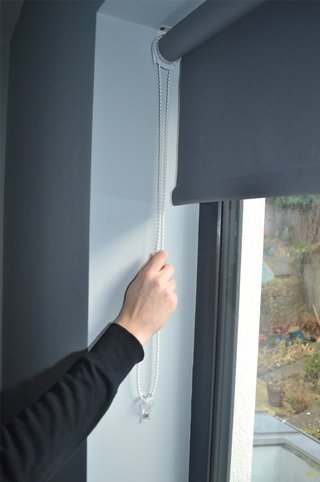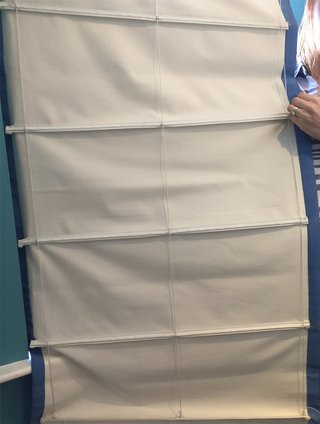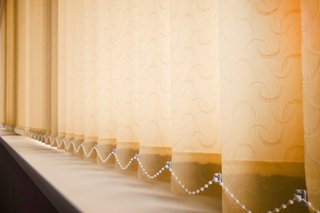Your child is at risk of being strangled by anything that's put around their neck.
This includes:
- cords and chains on window blinds and curtains
- strings and cords on clothes and wall-mounted lamps
- strings on household items
- chains, ribbons and strings on soothers
- bibs
- headbands
- hairbands
- jewellery, including amber teething jewellery
- electrical cords and wires
- ropes
- fixtures, furniture and fittings
Older children may share unsuitable objects with your child.
Do not allow children to play with string, cords, jewellery or ropes.
Clothes
Any item near the neck of a child could get caught.
Do not dress your baby or young child in:
-
clothes with strings or cords attached, like hoodies with drawstrings or ties on hats
-
jewellery, including amber teething jewellery
-
belts
-
ribbons
-
headbands
-
hairbands
-
clips
-
ties
Only use a dressing gown with a short belt that is securely attached to the gown.
Do not attach strings, ribbons or chains to soothers.
Bibs
Remove bibs once your child has finished eating and before putting them down to sleep.
Jewellery
Do not put jewellery, amber teething jewellery or ribbons on a child under the age of 3.
Blinds and curtains
Cords and chains on window blinds, door blinds and curtains can strangle children and cause death.
They are a risk to all children, particularly children under the age of 3. Cords and chains with loops are a particular risk.
Important
Remove all curtains and blinds with cords or chains from your home. Replace them with blinds or curtains that have no chains or cords.
This information is a guide only. Check with your blind or curtain supplier if you are unsure about the safety of your blinds. Ask them any queries you have.
Hidden dangers: window blinds
Buying new blinds or curtains
Buy cordless blinds, pull up blinds or curtains. Cordless blinds are blinds with no cords or chains. Some cordless blinds include a wand to pull them across.
Ask the shop staff if any blinds or curtains you buy meet current safety standards.
Keep wands out of reach of your child to prevent eye injuries.
If you are buying blinds with a safety device, check that the device meets current safety standards. Make sure it is fitted at the same time as the blind.
Follow the manufacturers instructions and warnings if you are fitting the blinds yourself.
Blinds and curtains - dangers to look out for
Check every blind or curtain on your windows or doors for:
- cords or chains
- hidden cords or chains
- inner cords or chains
- bottom chains
- curtains ties
- curtain tape
If a cord or chain is within your child’s reach, it is a danger. Cords and chains with loops are a particular risk.
Be particularly mindful of your child's bedroom, playroom and any other room they spend time in.
Check blinds and curtains in other places outside your home that your child might spend time. For example:
- child minders
- grandparents
- friends and family
- hotels
- restaurants

If you have blinds or curtains with cords or chains at home
Remove every blind or curtain with cords or chains from your home. Replace them with cordless versions instead. For example, blinds with wands.
If it is not possible to replace them, reduce the risk to children by:
- using a working safety device that meets safety standards
- not putting any furniture near a blind or curtain, as children love to climb
- removing any curtain tie-backs and storing them out of your child's reach
Make unsafe blinds and curtains safer
If you choose to keep your blinds or curtains with cords or chains, you can buy and install safety devices to keep them out of your child's reach.
Safety devices such as cord or chain tie-downs can pull the cord or chain tight and secure them to the wall or floor. This helps to prevent the risk of strangulation.
Other safety devices for blinds include:
- cord and chain tidies
- cord tension device
- chain break connectors
- inner cord or chain stops
- breakaway devices
- blind cord cleats

You can buy these child safety devices from companies that specialise in blinds. Talk to them about what is best for your situation.
Check that the device you choose is:
- fitted correctly
- stays in good working order
- meets current safety standards
Keep cords and chains at least 1.6 metres off the ground. But remember your child could still reach a cord or chain if they climb on furniture.
Keep furniture away from blinds or curtains
Check that furniture is not near windows and doors.
Even if you use a safety device, your child could climb up and get caught in the cord or chain. This is why the safest option is cordless blinds or curtains.
Never put your child near a window or door with a blind or curtain if they're in a:
- cot
- bed
- playpen
- high chair
Keep sofas, chairs, tables, shelves, toy boxes, bookcases or similar furniture away from windows or doors with blinds and curtains. This can help prevent children from climbing up and reaching cords and chains.
You should share this information with anyone who looks after your child.
Wall lamps with cords
Keep cords on wall-mounted lamps out of reach of young children. Keep them away from their cot, bed, high-chair and playpen.
Cots and beds
Strangulation or accidental hanging can happen when a child's head or neck is caught up in:
- clothing
- gaps between the mattress and the cot or bed
- rope tied to or near their cot or bed
Never tie belts, dressing gowns, ropes, cords or skipping ropes to a child's bed to store them. Do not hang bunting or other items on your child's cot or bed.
Keep hanging mobiles out of your baby’s reach. Also keep mobile strings short.
Be careful using second-hand or older cots and equipment. They may not meet current safety standards.
Cot death (sudden infant death syndrome)
Furniture and household items
Beware of the risk of your child getting trapped or strangled by:
- the bars of cots
- furniture with gaps
- stair banisters
- railings
Keep electrical and lamp cords away from cots, beds, high chairs and playpens.
Make sure all string, ropes, cords and jewellery are out of your child's reach.


